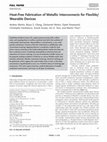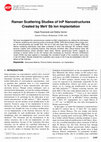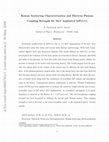Papers by Dipak Paramanik
APS Meeting Abstracts, 2008
The controlled formation of nano-dots, using ion beams as tool, has become important as it offers... more The controlled formation of nano-dots, using ion beams as tool, has become important as it offers a unique method to generate non-equilibrium phases with novel physical properties and structures with nano-dimensions. We have investigated the creation of self assembled nano-dots ...
Nano-scale materials: from science to technology, 2006
Advanced Functional Materials, 2019

Advanced Functional Materials, 2019
Exploiting interfacial excess (Γ), Laplace pressure jump (ΔP), surface work, and coupling them to... more Exploiting interfacial excess (Γ), Laplace pressure jump (ΔP), surface work, and coupling them to surface reactivity have led to the synthesis of undercooled metal particles. Metastability is maintained by a core-shell particle architecture. Fracture of the thin shell leads to solidification with concomitant sintering. Applying Scherer's constitutive model for loaddriven viscous sintering on the undercooled particles implies that they can form conductive traces. Combining metastability to eliminate heat and robustness of viscous sintering, an array of conductive metallic traces can be prepared, leading to plethora of devices on various flexible and/or heat sensitive substrates. Besides mechanical sintering, chemical sintering can be performed, which negates the need of either heat or load. In the latter, connectivity is hypothesized to occur via a Frenkel's theory of sintering type mechanism. This work reports heat-free, ambient fabrication of metallic conductive interconnects and traces on all types of substrates.
Defence science journal
Ion Irradiation is a technologically important technique to modify the surfaces. We have investig... more Ion Irradiation is a technologically important technique to modify the surfaces. We have investigated the patterning of InP(111) surfaces by low energy (3 keV) as well as high energy (1.5 Mev) ion beams. After low energy ion irradiation, surfaces exhibit well defined nano dots which ripen at initial stages but exhibit fragmentations at high fluences. The surface rms, at both the energies, displays a similar behaviour of initially increasing with increasing fluences but decreasing for higher fluences. The studies show some common features at these low and high energies, like the smoothening of surface beyond the a/c transition.
Nuclear Instruments and Methods in Physics Research Section B: Beam Interactions with Materials and Atoms, 2006
We have investigated the formation of nanosized structures on InP(1 1 1) surfaces after 1.5 MeV S... more We have investigated the formation of nanosized structures on InP(1 1 1) surfaces after 1.5 MeV Sb implantation. Scanning probe microscope (SPM) has been utilized to investigate the size, height and the density distributions of the nanostructures as a function of ion fluence. We observe nanostructures smaller than 100 nm and lower than 4 nm at all fluences. Moreover in large nanostructures we observe agglomeration of several smaller structures. We have also investigated the rms surface roughness of the InP(1 1 1) surfaces after MeV implantations.
International Journal of Nanoscience, 2004
The synthesis of the GaAs nanoparticles, having sizes 7 nm to 15 nm, by a low cost electrochemica... more The synthesis of the GaAs nanoparticles, having sizes 7 nm to 15 nm, by a low cost electrochemical technique has been reported. The absence of any foreign impurity has been confirmed by the Proton-Induced X-rays Emission analysis. Rutherford Backscattering measurement has been performed in order to estimate the thickness of the nanoparticle-generated thin film as a function of the electrolysis current density. The X-ray Photoelectron Spectroscopic study confirms the formation of GaAs and exhibits the binding energy shift of the core shell electrons as an implication of the nanostructure effect. Very weak infrared luminescence due to the radiative recombination of the impurity bound exciton has been detected from yttrium-doped GaAs nanocrystals, even at room temperature.

We study strain relaxation and surface damage of GaN nanopillar arrays fabricated using inductive... more We study strain relaxation and surface damage of GaN nanopillar arrays fabricated using inductively coupled plasma (ICP) etching and post etch wet chemical treatment. We controlled the shape and surface damage of such nanopillar structures through selection of etching parameters. We compared different substrate temperatures and different chlorine-based etch chemistries to fabricate high quality GaN nanopillars. Room temperature photoluminescence and Raman scattering measurements were carried to study the presence of surface defect and strain relaxation on these nanostructures, respectively. We found that wet KOH etching can remove the side wall damages caused by dry plasma etching, leading to better quality of GaN nanopillars arrays. The Si material underneath the GaN pillars was removed by KOH wet etching, leaving behind a fine Si pillar to support the GaN structure. Substantial strain relaxations were observed in these structures from room temperature Raman spectroscopy measurements. Room

MRS Proceedings, 2007
Fabrication of Nanodots on semiconductor surfaces has immense importance due to their application... more Fabrication of Nanodots on semiconductor surfaces has immense importance due to their application in memory and optoelectronic devices. Ion irradiation methods display an easy and cost effective route for developing self assembled structures. We have studied the formation of Nano-dots on InP(111) surfaces by 3keV Ar ion irradiation. The distribution of nano Dots on InP surfaces has been investigated by Scanning Probe Microscopy (SPM). A 5 min irradiation of InP surface with Ar ions leads to the appearance of dots on the surface. The density of dots is, however very small. These dots have been obtained at room temperature, in the absence of sample rotation, with an angle of 15 degree between the ion axis and the sample normal. After an irradiation of 10 min a large density of dots appear on InP surface and display a narrow distribution of size and height. The dots at this stage have an average diameter of 25nm and a height of 4nm. With increased irradiation time the average size and ...
SPIE Proceedings, 2012
ABSTRACT We report the systematic etching profile of GaN nano pillar structures using inductively... more ABSTRACT We report the systematic etching profile of GaN nano pillar structures using inductively coupled plasma (ICP) etching techniques. We were able to control the side wall angle, shape and dimension of such nanoscale structures by carefully selecting the etching parameters. We present the effects of variations of the etch parameters, such as ICP power, RF power, chamber pressure, and substrate temperature on the etch characteristics, such as etch rate, sidewall angle, anisotropy, mask erosion, and surface roughness. Utilizing such ...
Journal of Vacuum Science & Technology B, Nanotechnology and Microelectronics: Materials, Processing, Measurement, and Phenomena, 2014

Journal of Nanoscience and Nanotechnology, 2007
We have investigated the nanostructures created via MeV implantations by utilizing the techniques... more We have investigated the nanostructures created via MeV implantations by utilizing the techniques of Raman scattering and scanning probe microscope (SPM). SPM demonstrates that a large number of nanostructures are smaller than 100 nm in size and lower than 4 nm in height. SPM and Raman scattering techniques have been combined to show that although InP surfaces initially become rougher with increasing fluence, they become smoother after critical fluence when the crystalline/amorphous phase transition takes place. Raman spectroscopy further suggests an increase in tensile stress on the InP surface with increasing ion fluences. Phonon confinement model (PCM) has been applied to investigate the correlation length of the crystalline nano-zones in the InP lattice. Results indicate that crystalline nano-zones of 35 Å may be embedded in the InP lattice at high fluences.
Journal of Nanoscience and Nanotechnology, 2008
The scaling parameters have been studied here for InP(111) surfaces that evolve after implantatio... more The scaling parameters have been studied here for InP(111) surfaces that evolve after implantation with MeV ions. The surfaces show the development of nano pattern and kinetic roughening. Growth exponent β, roughening exponent and the characteristic wavelength have been studied here at several fluences. Scaling parameters suggest that the surface evolution can not be explained by linear Bradley Harper model or by Kuramoto-Sivashinsky model alone.

Journal of Applied Physics, 2007
Structural modifications in InP(111) due to 1.5 MeV implantation of Sb have been characterized us... more Structural modifications in InP(111) due to 1.5 MeV implantation of Sb have been characterized using first order and second order Raman spectroscopy. With both Longitudinal Optical (LO) and Transverse Optical (TO) modes allowed for InP(111), we have investigated the evolution of both these modes as a function of fluence. Intensity, linewidth and shifts of the phonons, for both first order and second order Raman modes, display the increase in damage in the lattice with increasing fluence. The results suggest that the presence of a charge layer in the vicinity of the surface may be effecting the first order Raman data. A LO phonon-plasmon coupled mode, due to the charge layer, has also been observed that becomes sharper and more intense with increasing fluence. Results also show the presence of tensile stress along with the coexistence of crystalline InP regions and amorphous zones in the lattice. Consequently phonon confinement is observed. Phonon Confinement model (PCM) has been applied here to estimate the coherence length and the size of nanocrystalline zones in InP lattice after implantation. A crystalline/ amorphous (c/a) phase transition is observed at the fluence of 1 × 10 14 ions/cm 2. The electron-phonon coupling strength has been measured by utilizing the second order Raman modes. This coupling strength is seen to decrease as the nano-crystalline zones, in the implanted lattice, become smaller.
Applied Surface Science, 2012
Nanodots have been fabricated on rutile TiO 2 (1 1 0) single crystals using Ar ion beam. Ion beam... more Nanodots have been fabricated on rutile TiO 2 (1 1 0) single crystals using Ar ion beam. Ion beam sputtering creates oxygen vacancies, leading to a 45 nm thick Ti rich layer, on the surface. Post-sputtering, rutile TiO 2 also exhibits a decrease in the inter planar separation along [1 1 0] direction. Additionally, blueshift in the E g Raman mode, representing the vibrations of oxygen atoms along c-axis, is also observed. Both these results suggest the development of a compressive stress along c-axis upon sputtering. Enhancement in intensity of A 1g Raman mode also indicates modification in Ti O vibrational influence.
Applied Physics Letters, 2012
We present large-area, vertically aligned GaN n-core and p-shell structures on silicon substrates... more We present large-area, vertically aligned GaN n-core and p-shell structures on silicon substrates. The GaN pillars were formed by inductively coupled plasma etching of lithographically patterned n-GaN epitaxial layer. Mg-doped p-GaN shells were formed using selective overgrowth by halide vapor phase epitaxy. The diameter of the cores ranged from 250 nm to 10 lm with varying pitch. The p-shells formed truncated hexagonal pyramids with {1 101} side-facets. Room-temperature photoluminescence and Raman scattering measurements indicate strain-relaxation in the etched pillars and shells. Cross-sectional transmission electron microscopy revealed dislocation bending by 90 at the core-shell interface and reduction in their density in the shells. V











Uploads
Papers by Dipak Paramanik